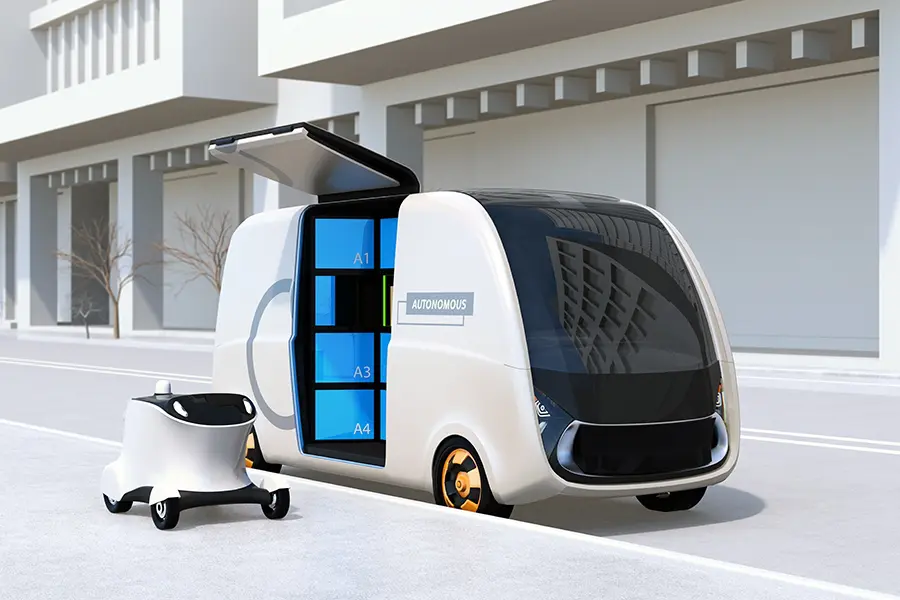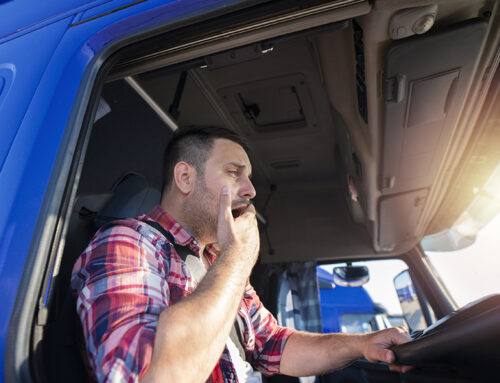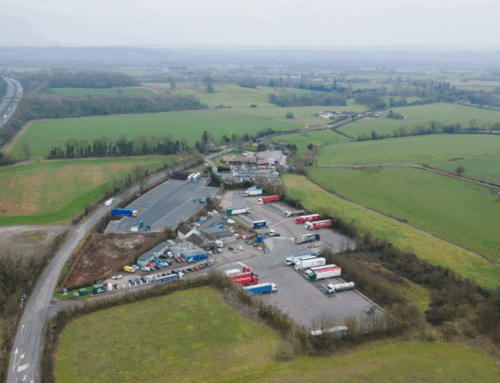Autonomous fleets – have your say
The Law Commission is nearing the end of their third consultation paper on a regulatory framework for automated vehicles. While fully autonomous vehicles may be some way off, they raise some important questions around risk management, especially for fleet operators and we’ve recently discussed some of those implications with their team.
They would like as much input as possible to this discussion. There are a large number of questions in the overall consultation that need input – however you don’t need to answer all of them, and even an answer to just one or two would prove helpful.
We’ve put together an introduction below with an extract from chapter 6 of the Consultation Summary document along with 6 questions that are most relevant to fleet operators.
Please have a read through the following information and, if you would like to provide some useful input, you can submit answers to one or more questions at https://www.lawcom.gov.uk/project/automated-vehicles/
The deadline is officially 18th March however if you would like to contribute but require more time please contact Jessica Uguccioni at the Law Commission.
From the Law Commission
We are pleased to announce the publication of our third and final consultation paper, launching a three month public consultation.
As you may recall in 2018 the Centre for Connected and Autonomous Vehicles (CCAV) asked the Law Commissions to review the regulatory framework for the safe deployment of automated vehicles on British roads and make final recommendations for legal change in 2021. Today’s paper builds on the work in our first and second consultations on safety assurance, allocating legal responsibility, and licensing AVs for passenger services and public transport.
During this three month consultation we welcome views on key questions including:
- the legal meaning of “self-driving”: the extent of residual responsibility linked with human intervention following transition demands and other events, and ‘how safe is safe enough’. We use Automated Lane Keeping Systems (ALKS) as a case study.
- a GB safety assurance scheme for automated vehicles, analysed in the context of the UK’s international obligations. We consider in-use safety including effective monitoring of real-world performance, collision investigation and regulation of software updates.
- the extent of criminal liability of corporations and senior managers which put AVs forward for approval.
- access to data that may be required by law to enable the regulatory scheme for AVs to function.
We invite you to respond to the paper by 18 March 2021. We have set up an online portal for submitting responses but welcome input in any format. If you have ideas for consultation events or would like a meeting please get in touch.
The consultation paper, summary and details for how to respond are available on our project page at https://www.lawcom.gov.uk/project/automated-vehicles/
Extracts from Chapter 1 of the summary:
THREE KEY ACTORS
1.6 This consultation builds on our previous papers to propose three legal actors to take legal responsibility for how an AV drives.
(1) The Automated Driving System Entity (or ADSE) is the manufacturer or developer who puts the vehicle forward for categorisation as self-driving. It must register with the safety assurance regulator as the first point of contact if things go wrong. Our proposals retain some flexibility about who the ADSE is: it may be a vehicle manufacturer, or software developer, or a partnership between the two. However, the ADSE must show that it was closely involved in assessing the safety of the vehicle. It must also have sufficient funds to respond to regulatory action and to organise a recall.
(2) The user-in-charge can be thought of as the human in the driving seat of an AV while an ADS is engaged. Under our proposals, every AV will need a user-in-charge unless it is authorised to operate without one. As automation develops, the idea of a traditional driving seat might change. We have therefore developed the idea of a user-in-charge to deal with new features, such those which park or summon a car automatically. In Chapter 12 we define the user-in-charge as an individual in the vehicle or in direct sight of the vehicle with access to the controls.
The user-in-charge must be qualified and fit to drive, as they may be called on to take over driving following a transition demand. They are not responsible for the dynamic driving task but they do retain other driver responsibilities.
(3) A licensed fleet operator is responsible for the remote operating of vehicles with no user-in-charge. A fleet operator is an organisation rather than an individual, which supervises vehicles using connectivity rather than direct sight.
All operators will be subject to basic Tier 1 duties, such as maintaining and supervising vehicles and reporting incidents. They may also be subject to additional Tier 2 duties if, for example, they are running a passenger service or operating heavy goods vehicles.
Extract from chapter 6 of the Summary:
THE CHALLENGE OF REMOTE OPERATION
6.7 Remote operation of vehicles is a step into the unknown. Despite several trials and increased interest in the subject, there is little public information about how it might work.
6.8 In Chapter 13 we explore a variety of challenges, including connectivity; how to maintain situational awareness through a screen with no sense of motion; and how to combat boredom, distraction and inattention. We note regulations on rest periods for air traffic controllers and safety critical work in railway operation centres.
6.9 At this stage, we are not attempting to suggest how many vehicles can be supervised at once, what information should be displayed or what hours remote assistants might work. However, any legislation should be sufficiently flexible to deal with such issues.
A NEW SCHEME OF OPERATOR LICENSING
6.10 In Consultation Paper 2 we considered an operator licensing scheme for highly automated road passenger services (HARPS). Although our proposals were broadly welcomed, several consultees were concerned that the safeguards were confined to passenger services. They thought that a similar licensing system should apply to all self-driving vehicles which did not have a user-in-charge, including those which are privately owned. This has led us to rethink our proposals.
All NUICs should be covered by a licensed operator
6.11 We now propose a more streamlined scheme. Initially, all NUICs should be supervised and maintained by a licensed operator, irrespective of whether they are used for private or business purposes, and whether or not they carry passengers.
6.12 A private individual may still own a NUIC vehicle, but they must contract with a licensed operator for supervision and maintenance services, including installing software and maintaining cybersecurity. It would be a criminal offence to use a NUIC which is not covered by a licensed operator.
The distinction between and ADSE and the operator
6.13 Our scheme draws a distinction between the ADSE and the operator. The ADSE is responsible for the ADS design; the operator for day-to-day use. This dual approach contrasts with the position taken by the Uniform Law Commission in the USA. It proposes that a single “Automated Driving Provider” should covers all aspects of complying with the technical and legal requirements for AVs.
6.14 An advantage of taking an integrated approach is that a single organisation would take responsibility for all aspects of safety. If something goes wrong, the ADSE and operator could not blame each other. A disadvantage is that it would reduce competition. It could give a few major developers a monopoly of all automated passenger and freight services, reducing innovation in how these services are provided and increasing prices. We ask for views.
Consultation Question 38.
6.15 We provisionally propose that:
(1) the regulation of self-driving vehicles should distinguish between an Automated Driving System Entity (which vouches for the design of the system) and an operator (responsible for the operation of individual vehicles);
(2) all vehicles authorised for use on roads or other public places with no user-in-charge should either:
(a) be operated by a licensed operator; or
(b) be covered by a contract with a licensed operator for supervision and maintenance services;
(3) it should be a criminal offence to use a NUIC vehicle on a road or other public place unless it is operated by a licensed operator or is covered by a contract with a licensed operator for supervision and maintenance services.
Do you agree?
Operator requirements
6.16 The requirements for NUIC operators would mirror the proposals we originally made for HARPS operators. A strong majority of consultees (76%) agreed that HARPS operators should be of good repute; have appropriate financial standing; have an effective and stable establishment in Great Britain; and be professionally competent. We think these requirements should also apply to NUIC operators.
6.17 In Consultation Paper 2 we proposed that professional competence should be demonstrated by having a suitable transport manager, as with public service vehicle licensing. Many consultees supported the idea, pointing out that many of the current transport management skills would continue to be relevant. Others, however, stressed the need for new skills in remote operation, software installation and technology. Developers thought we should move away from the idea of a single qualified individual. Instead organisations should demonstrate competence through a safety management system. We ask for views.
39 Consultation Question 39.
6.18 We welcome views on whether NUIC operators should be required to demonstrate professional competence through a safety management system, as set out in a safety case.
Operator duties: Tier 1
6.19 Under our new scheme, all licensed operators would need to comply with basic “Tier 1 duties”. Operators must take action if their vehicles are causing a danger or obstruction (which we refer to as “supervision”). They must also maintain and insure vehicles, install safety-critical updates and report accidents. We think that their duty to report accidents should go beyond the duty of all drivers under section 170 of the Road Traffic Act 1988. It should include responding to the regulator’s requests for information on other untoward events, together with background information about miles travelled.
6.20 The obligation to use a licensed operator would be subject to a regulation-making power. Regulations could be made to transfer some responsibilities (such as insurance) to those who own or use vehicles for private purposes, if it is safe to do so.
Consultation Question 40.
6.21 We provisionally propose that, irrespective of the nature of the vehicle, a licensed operator should be under a duty to:
(1) supervise the vehicle;
(2) maintain the vehicle;
(3) insure the vehicle;
(4) install safety-critical updates and maintain cybersecurity; and
(5) report accidents and untoward events (as defined by the regulator).
Do you agree?
Consultation Question 41.
6.22 We provisionally propose that legislation should include a regulation-making power by which some or all of these duties could be transferred to the registered keeper or owner, if it was shown that it was appropriate to do so.
Do you agree?
Operator duties: Tier 2
6.23 Although supervision, maintenance, insurance and reporting would apply to all those who operated NIUCs, other duties would only apply to HARPS operators, who carry passengers as a commercial service. These include accessibility, safeguarding passengers and giving price information.
6.24 We envisage that other “Tier 2” duties may also apply to freight services, covering (for example) loading and coupling/uncoupling cabs and trailer. However, we have not consulted on freight-specific requirements because our terms of reference focus on passenger transport. This issue will require further consideration.
National minimum accessibility standards for HARPS
6.25 Responses to our second consultation supported national minimum accessibility standards for automated passenger services, both for vehicle design and the whole HARPS user experience.
6.26 We wish to ensure that these minimum standards take account of the lived experience of disabled and older persons. We provisionally propose that, before setting standards, the Secretary of State should consult the Equalities and Human Rights Commission and disabled representative groups. The panel should also be re-consulted at set intervals to ensure requirements keep pace with technical advancements and changing needs. We seek views.
Consultation Question 42.
6.27 We welcome views on how accessibility standards for Highly Automated Road Passenger Services (HARPS) might be developed.
6.28 We provisionally propose that: (1) an accessibility advisory panel should be formed to include: (a) the Equalities and Human Rights Commission; and
(b) representative groups for disabled and older persons;
(2) the Secretary of State should be obliged to consult with the accessibility advisory panel prior to setting any national minimum standards on HARPS;
(3) there should be a duty to periodically re-consult the accessibility advisory panel at set intervals to ensure requirements keep pace with developing evidence of technical feasibility and changing needs.
Do you agree?
6.29 We welcome views on what the set interval for periodically re-consulting the accessibility advisory panel should be.
Who should administer the operator licensing scheme?
6.30 In Consultation Paper 2 we asked who should administer the scheme for HARPS operator licensing. This drew a variety of responses. Some consultees saw the Traffic Commissioners as the natural fit, as they have considerable experience of licensing passenger and freight operators. It would also mean that an operator which ran both automated and conventional services would only need to deal with one body.
6.31 Alternatively, responsibility could be placed on the in-use safety assurance regulator. This agency could develop expertise in the challenges of automated driving and would be able to resolve demarcation issues between the two schemes. Some consultees argued for a new body. Others mentioned bringing a variety of expertise together within new collaborative structures.
6.32 It is difficult to evaluate the strength of these approaches without a greater understanding of how NUICs will be used, or how far remote operation raises new challenges. We continue to have an open mind on this issue and would welcome further observations.
Consultation Question 43.
6.33 We welcome views on who should administer the operator licensing scheme.






